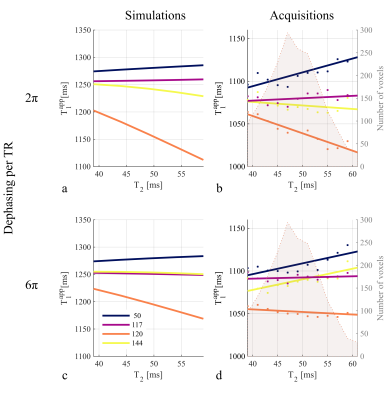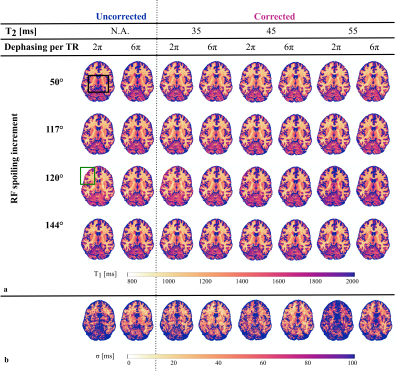Nadège Corbin1,2 and Martina F. Callaghan1
1Wellcome Centre for Human Neuroimaging, UCL Queen Square Institute of Neurology, University College London, London, United Kingdom, 2Centre de Résonance Magnétique des Systèmes Biologiques, UMR 5536, CNRS/University Bordeaux, Bordeaux, France
1Wellcome Centre for Human Neuroimaging, UCL Queen Square Institute of Neurology, University College London, London, United Kingdom, 2Centre de Résonance Magnétique des Systèmes Biologiques, UMR 5536, CNRS/University Bordeaux, Bordeaux, France
Imperfect spoiling introduces a bias in T1 times estimated with the approach. Here we investigate, in-vivo at 7T, in multiple spoiling conditions, the T2 dependence of the bias. We recommended to use radiofrequency spoiling increment of 117° or 144° with sufficient spoiling gradient (6π).

Figure 1: In vivo T1app,
obtained with $$$\phi_0\in$$$[50°,117°,120°,144°], as a function of T2.
Dephasing across a voxel of 2π (a-b) and 6π (c-d) per TR are shown. (a,c)
Numerical simulations. Fixed parameters are: T1=1250ms, D=0.8µm2/ms, fB1+=80% as measured in the transmit field map in the
slice of interest. (b,d) Acquisitions and linear fitting for illustration
purposes. The number of voxels included in each bin is depicted by the shaded
background of each graph.

Figure 2: (a) Axial view from T1 maps obtained
with a dephasing per TR of 2π (columns 1, 3, 5 and 7) or 6π (columns 2, 4, 6 and 8) for each φ0 (rows). These are presented before (i.e.
T1app, columns 1 and
2) and after correction for imperfect spoiling with D=0.8µm2/ms and T2 of either 35ms
(columns 3 and 4), 45ms (columns 5 and 6) or 55ms (columns 7 and 8). Black and green boxes highlight
areas particularly affected by changing or applying correction factors (c) Maps of σ,
the voxel-wise standard deviation of T1 across RF spoiling
increments for a given condition (i.e. along columns in (a)).
